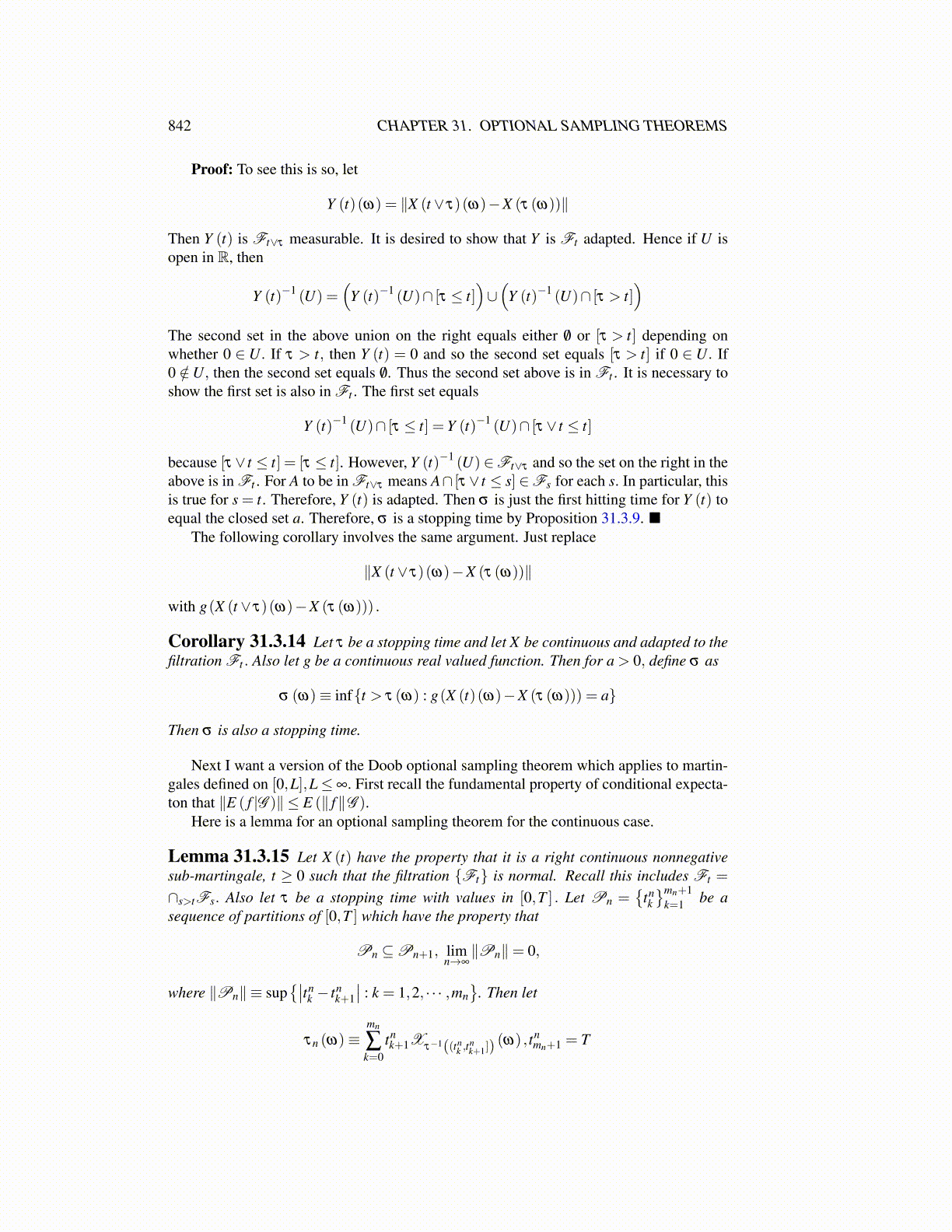
842 CHAPTER 31. OPTIONAL SAMPLING THEOREMS
Proof: To see this is so, let
Y (t)(ω) = ∥X (t ∨ τ)(ω)−X (τ (ω))∥
Then Y (t) is Ft∨τ measurable. It is desired to show that Y is Ft adapted. Hence if U isopen in R, then
Y (t)−1 (U) =(
Y (t)−1 (U)∩ [τ ≤ t])∪(
Y (t)−1 (U)∩ [τ > t])
The second set in the above union on the right equals either /0 or [τ > t] depending onwhether 0 ∈ U. If τ > t, then Y (t) = 0 and so the second set equals [τ > t] if 0 ∈ U. If0 /∈U, then the second set equals /0. Thus the second set above is in Ft . It is necessary toshow the first set is also in Ft . The first set equals
Y (t)−1 (U)∩ [τ ≤ t] = Y (t)−1 (U)∩ [τ ∨ t ≤ t]
because [τ ∨ t ≤ t] = [τ ≤ t]. However, Y (t)−1 (U) ∈Ft∨τ and so the set on the right in theabove is in Ft . For A to be in Ft∨τ means A∩ [τ ∨ t ≤ s] ∈Fs for each s. In particular, thisis true for s = t. Therefore, Y (t) is adapted. Then σ is just the first hitting time for Y (t) toequal the closed set a. Therefore, σ is a stopping time by Proposition 31.3.9. ■
The following corollary involves the same argument. Just replace
∥X (t ∨ τ)(ω)−X (τ (ω))∥
with g(X (t ∨ τ)(ω)−X (τ (ω))) .
Corollary 31.3.14 Let τ be a stopping time and let X be continuous and adapted to thefiltration Ft . Also let g be a continuous real valued function. Then for a > 0, define σ as
σ (ω)≡ inf{t > τ (ω) : g(X (t)(ω)−X (τ (ω))) = a}
Then σ is also a stopping time.
Next I want a version of the Doob optional sampling theorem which applies to martin-gales defined on [0,L],L≤∞. First recall the fundamental property of conditional expecta-ton that ∥E ( f |G )∥ ≤ E (∥ f∥G ).
Here is a lemma for an optional sampling theorem for the continuous case.
Lemma 31.3.15 Let X (t) have the property that it is a right continuous nonnegativesub-martingale, t ≥ 0 such that the filtration {Ft} is normal. Recall this includes Ft =
∩s>tFs. Also let τ be a stopping time with values in [0,T ] . Let Pn ={
tnk
}mn+1k=1 be a
sequence of partitions of [0,T ] which have the property that
Pn ⊆Pn+1, limn→∞∥Pn∥= 0,
where ∥Pn∥ ≡ sup{∣∣tn
k − tnk+1
∣∣ : k = 1,2, · · · ,mn}
. Then let
τn (ω)≡mn
∑k=0
tnk+1Xτ−1((tn
k ,tnk+1])
(ω) , tnmn+1 = T